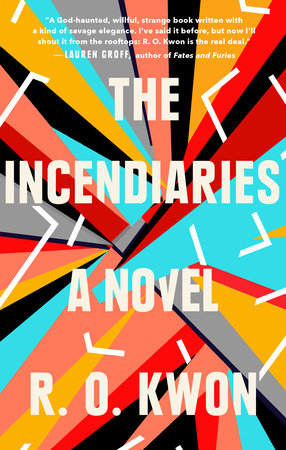My obsession with fires and burns comes from the accident that happened when I was 10, during our last winter in Korea. School had just let out, and I’d walked into the shed outside our one-room home that served as our kitchen. Standing on the uneven concrete floor, I caught a whiff of a broth cooking on the knee-high stove and crouched down to see what it was when my school bag caught the pot handle.
It was almost 40 years ago, but close my eyes, and I can still see it—the broth swishing around the pot like a tidal wave, the boiling bubbles popping as the pot tilts down, the liquid hitting my navy knit leggings. My mother dragging me to the water pump, the rising steam from my leggings dissipating into the air. Scissors cutting through the leggings, my mother’s hands shaking so badly she had to use both hands to cut. Bits of white fuzz—my skin—all over the knitted cloth.
Strangely, I don’t remember any pain at the moment of the incident itself. The pain came later, during the following month when I stayed in our room, taking all the medication my aunt could sneak out of the pharmacy where she worked (we were too poor to afford the hospital) and my mother changed the dressing six times a day, buttering my raw, red flesh with antibiotic ointment.
That was the most painful thing I’ve ever gone through, and the trauma stayed with me long after the burns healed. I’m no psychoanalyst, but I’m guessing that has something to do with my obsession with books about burning—fires, explosions, acid, scarred victims, all of it. In fact, my first novel, Miracle Creek, starts with a fire and an explosion, and that horrific incident gives rise to the murder trial that anchors the novel. But my real interest isn’t in the incident itself, but rather, in using it to explore the before and after—the history of the relationships between the characters, and the unexpected ways that their lives changed after the fire.
Here are seven stunning books in which fires/explosions/burnings give rise to the story, but are about much more, in which the fires are quasi-MacGuffins that the authors use to great effect to explore the lives of the people affected by them:

Did You Ever Have a Family by Bill Clegg
On the morning of June’s daughter’s wedding, a gas leak causes an explosion and fire in her house, killing her daughter, the daughter’s fiancé, her ex-husband, and her boyfriend. It’s devastating, not only for June (who leaves town and drives across the country) but for the other family members of the victims and other residents of the small Connecticut town. Bill Clegg masterfully delves into the aftermath in poignant, tender vignettes, and we learn, little by little, what led to the fire and glimpse the devastating consequences for the town.

The Incendiaries by R.O. Kwon
This dazzling novel begins with an explosion, a bomb that destroys a building as those responsible—Phoebe Lin, John Leal, and the other members of their religious cult—look on from a nearby rooftop and shout in triumph. Or so imagines Will, who wasn’t there but pictures the scene as it must have played out. Who are Phoebe, John, and Will, and what is this explosion all about? In sparkling prose, R.O. Kwon explores the forces of obsession, grief, and fundamentalism that led these characters to that moment. I can’t count how many times I paused to re-read a passage, marveling at its precision, its conciseness, and most of all, its rhythm. (Describing the explosion: “Three minutes to go, two, one. The Phipps building fell. Smoke plumed, the breath of God.”) You can tell that R.O. Kwon slaved over every word, every sentence, every paragraph. The result is a powerful must-read.

Little Fires Everywhere by Celeste Ng
“Everyone in Shaker Heights was talking about it that summer: how Isabelle, the last of the Richardson children, had finally gone around the bend and burned the house down.” So begins the opening chapter, which is centered around the fire, including the reactions of the Richardson family and their neighbors, the descriptions of the firefighting effort, and the discovery that the fire was the result of multiple fires deliberately set in the middle of all the beds in the house. Celeste Ng then takes us back in time to take us into the lives of the Richardsons and the other families in their planned community, as we uncover the secrets and complex dynamics that eventually led to those little fires everywhere.

In the Lake of the Woods by Tim O’Brien
After a humiliating loss in an election for the US Senate, John Wade is hiding away in a remote lakeside cabin with his wife Kathy when he wakes up one morning to find her and their boat missing. His only memories of that night: boiling water in their iron tea kettle and pouring it on their potted plants, killing them. Through a series of Hypotheses chapters, Tim O’Brien tantalizes us with what could have happened—she could have run away, he could have killed her using the boiling water and thrown her body in the lake, she could have gone for a boat ride and gotten lost, or this whole thing could be an elaborate ruse for them to disappear and make a new life for themselves. Through interspersed flashbacks, we see what’s at the root of John’s traumatized life and his landslide election loss: his role in the My Lai Massacre in the Vietnam War. Trees on fire, smoke billowing around bodies and houses, explosions. It’s a powerful novel with a brilliantly unconventional structure. Easily one of my top five favorite books ever.

The Library Book by Susan Orlean
This isn’t a novel, but I’m making an exception because this is an exceptional book. The Library Book is a nonfiction account of the devastating 1986 fire of the Los Angeles Central Public Library, which burned for seven hours and destroyed 400,000 books. The fire was what initially hooked me—Orlean’s description of the fire itself (“feeding itself book after book, a monster snacking on crisps”) and the mystery of who or what caused the fire—but what made me fall in love with this book were the colorful, fascinating stories about libraries, librarians, and the people associated with them, from Susan Orlean’s own mother to Harry Peak, the chief suspect. It’s a gift to those of us who love books and reading.

Fahrenheit 451 by Ray Bradbury
How can we talk about book burning without mentioning this great classic? Fahrenheit 451 is, as the book tells us, the temperature at which book paper catches fire and burns. In this dystopian “future” (in quotes because the book was published in 1953, and Ray Bradbury has said that the book takes place in 1999), books are outlawed and “firemen” burn any they find. The concept alone is striking, but the book is most chilling when it depicts the shocking consequences of this threat to our liberty, as when the firemen raid an old woman’s house, and she sets fire to her own house, killing herself rather than leave her books to be destroyed.

Firestarter by Stephen King
All right, fire is not a Trojan Horse for the real story in this sci-fi/horror/thriller from The King; fire is the real story. But I can’t have a list of books that start with fires and not include a book called Firestarter! Besides, it’s special to me for several reasons: 1) It was published in 1980, the year of my boiling-broth accident; 2) 1980 is also when I moved to America, learned to speak English, and started reading books in English; and 3) Firestarter was the first Stephen King book I ever read. Also, the film version starred Drew Barrymore, whom I idolized during that post-E.T. era.
Charlie has pyrokinesis, the ability to start fires. The Shop, a secret government unit (which, oh, by the way, performed experiments on her parents, which is what caused her extraordinary power), is after her, and she and her father are on the run. Pure suspenseful fun, with fires and explosions galore.
The post 7 Incendiary Books About Fires appeared first on Electric Literature.
Source : 7 Incendiary Books About Fires











